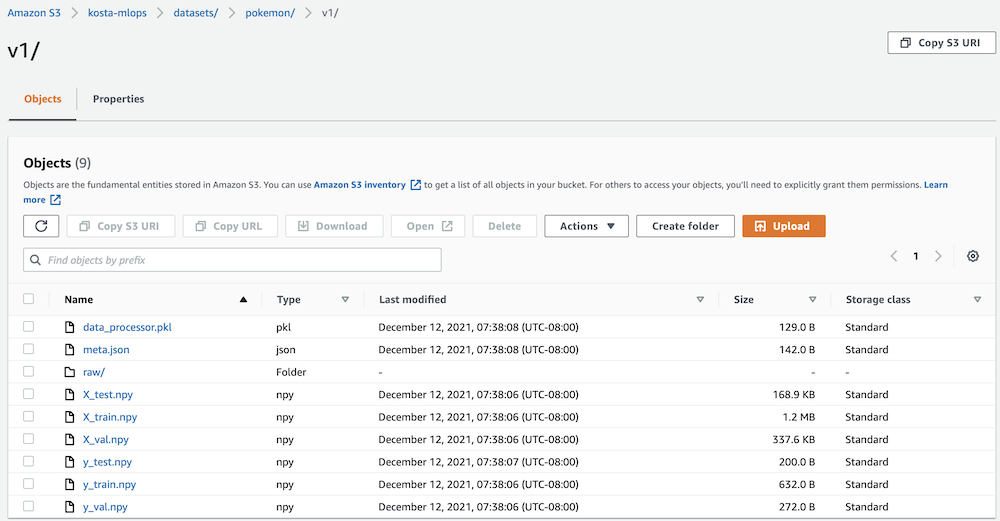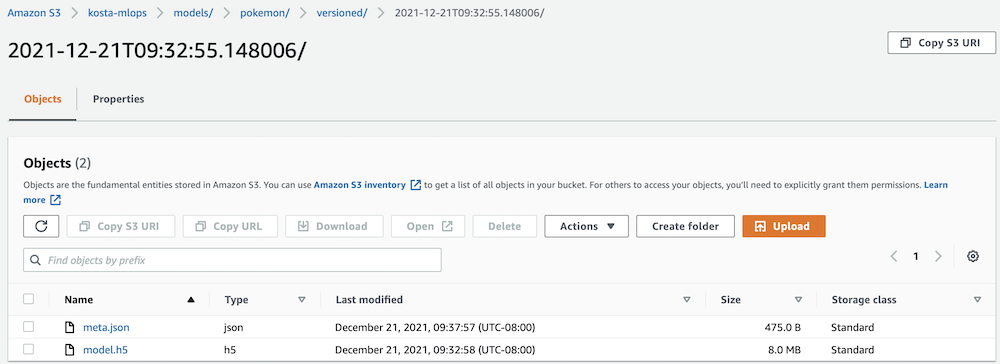mlops is a package that enables software engineering within an MLOps framework by providing:
- Seamless dataset and model versioning
- Publication of versioned datasets and models to local and Cloud filesystems
- Serialization and reproducibility of the data processing pipeline for each versioned dataset, so that new prediction or training data can be pre- and post-processed according to the arbitrary transformations that produced the original dataset
- Capturing of dataset and model metadata, including the connection of models to the datasets on which they were trained/validated/tested
- A common framework for data processing and model prototyping
pip install mloperationsFor the Sphinx API docs, please see the project's GitHub Pages.
MLOps as a software engineering methodology for ML, and by extension this package that aims to enable MLOps, is designed to improve the quality and decrease the time to market of ML systems. One key component that this package automates, dataset and model versioning, supports arbitrary rollback to previous dataset and model combinations so that any results the ML team has achieved can be effortlessly reproduced.
Consider the following motivating scenario. Your team creates a dataset and trains an initial ML model to 98% accuracy. You hypothesize that you can improve the accuracy, so you experiment with many datasets and models. Over several months, your next-best dataset/model achieve only 95% accuracy. You might have your old model saved, but you've changed the dataset so many times that you can't reproduce the original input to your ML model. You have no idea how to put the model into production, because no new data can be processed according to the transformations (of which you have no record) that produced your original dataset. There may be a way to piece together the original dataset from your VCS history, but it will be painful and costly. With dataset and model versioning, you could have avoided this situation.
When you call VersionedDatasetBuilder's publish(), the following files will be generated:
*.npy: Tensors for training, validation, testing, and/or prediction (as defined by the user)data_processor.pkl: The serialized data processor objectmeta.json: Metadata, including creation time, dataset hash, and tagsraw: The raw dataset, either directly copied or linked (as defined by the user)
Consider the image classification example, in which Pokemon images are classified
by type. The following is the result of calling publish('datasets/pokemon', version='v1'):
datasets/pokemon/
└── v1
├── X_test.npy
├── X_train.npy
├── X_val.npy
├── data_processor.pkl
├── meta.json
├── raw
│ ├── images
│ │ ├── blastoise.png
│ │ ├── bulbasaur.png
│ │ ├── charizard.png
│ │ ├── charmander.png
│ │ ├── charmeleon.png
│ │ ├── ivysaur.png
│ │ ├── squirtle.png
│ │ ├── venusaur.png
│ │ ├── wartortle.png
│ │ └── zapdos.png
│ └── pokemon.csv
├── y_test.npy
├── y_train.npy
└── y_val.npy
The dataset can be published to a Cloud store such as S3 by specifying a URL instead of a local path. For example, the
following is the result of calling publish('s3://kosta-mlops/datasets/pokemon', version='v1'):
VersionedModelBuidler's publish() creates the following files:
model.h5: The saved model (the user decides whether the model is saved at the last epoch, best epoch, etc.)meta.json: Metadata, including creation time, model hash, tags, training history, hyperparameters, and a link to the versioned dataset on which the model was trained.
Again in the image classification example, the following is the result of
publish('models/pokemon/versioned'). If no explicit version is supplied, the timestamp is used as the version.
models/pokemon/versioned/
├── 2021-12-19T06:59:00.451852
│ ├── meta.json
│ └── model.h5
Publish to a Cloud store with publish('s3://kosta-mlops/models/pokemon/versioned'):
See the project examples directory for worked and tested examples.
First, create a concrete subclass of abstract DataProcessor that tells
VersionedDatasetBuilder objects how to transform raw data files into feature
and label tensors.
You can also extend InvertibleDataProcessor if you want to be able to invert
preprocessing transformations. This capability helps with model input and output
interpretability, since it's not always readily apparent what the raw input and
output of a model mean to human beings.
import numpy as np
from mlops.dataset.data_processor import DataProcessor
class MyDataProcessor(DataProcessor):
"""Transforms a raw dataset into features and labels for downstream model
training, prediction, etc."""
def get_raw_features_and_labels(self, dataset_path: str) -> \
(dict[str, np.ndarray], dict[str, np.ndarray]):
"""Returns the raw feature and label tensors from the dataset path. This
method is specifically used for the train/val/test sets and not input
data for prediction, because in some cases the features and labels need
to be read simultaneously to ensure proper ordering of features and
labels.
For example, when handling image data, the raw features would likely be
tensors of shape m x h x w x c, where m is the number of images, h is
the image height, w is the image width, and c is the number of channels
(3 for RGB), with all values in the interval [0, 255]. The raw labels
may be tensors of shape m, where m is the number of examples, with all
values in the set {0, ..., k - 1} indicating the class.
:param dataset_path: The path to the file or directory on the local or
remote filesystem containing the dataset, specifically
train/val/test and not prediction data.
:return: A 2-tuple of the features dictionary and labels dictionary,
with matching keys and ordered tensors.
"""
# Your code here.
pass
def get_raw_features(self, dataset_path: str) -> dict[str, np.ndarray]:
"""Returns the raw feature tensors from the dataset path. The raw
features are how training/validation/test as well as prediction data
enter the data pipeline. For example, when handling image data, the raw
features would likely be tensors of shape m x h x w x c, where m is the
number of images, h is the image height, w is the image width, and c is
the number of channels (3 for RGB), with all values in the interval
[0, 255].
:param dataset_path: The path to the file or directory on the local or
remote filesystem containing the dataset.
:return: A dictionary whose values are feature tensors and whose
corresponding keys are the names by which those tensors should be
referenced. For example, the training features (value) may be called
'X_train' (key).
"""
# Your code here.
pass
def preprocess_features(self, raw_feature_tensor: np.ndarray) -> np.ndarray:
"""Returns the preprocessed feature tensor from the raw tensor. The
preprocessed features are how training/validation/test as well as
prediction data are fed into downstream models. For example, when
handling image data, the preprocessed features would likely be tensors
of shape m x h x w x c, where m is the number of images, h is the image
height, w is the image width, and c is the number of channels (3 for
RGB), with all values in the interval [0, 1].
:param raw_feature_tensor: The raw features to be preprocessed.
:return: The preprocessed feature tensor. This tensor is ready for
downstream model consumption.
"""
# Your code here.
pass
def preprocess_labels(self, raw_label_tensor: np.ndarray) -> np.ndarray:
"""Returns the preprocessed label tensor from the raw tensor. The
preprocessed labels are how training/validation/test as well as
prediction data are fed into downstream models. For example, in a
classification task, the preprocessed labels may be tensors of shape
m x k, where m is the number of examples, and k is the number of
classes, where each of the k-length vectors are one-hot encoded.
:param raw_label_tensor: The raw labels to be preprocessed.
:return: The preprocessed label tensor. This tensor is ready for
downstream model consumption.
"""
# Your code here.
passUse a VersionedDatasetBuilder to build and publish a dataset. You can publish the
dataset to the local filesystem or a cloud store like S3. VersionedDatasetBuilder
objects publish versioned datasets, which can be loaded directly from their paths.
This relationship ensures that every instantiated VersionedDataset object is in
the dataset repository (i.e., you can't create an "unversioned"
VersionedDataset).
The VersionedDataset
is important to model development because it standardizes the training/validation/test datasets,
providing a common point of comparison between models. It also captures the
transformations required to feed data into models using the data_processor
property. During publication, the VersionedDatasetBuilder serializes the data processor
and adds it to the dataset repository as an artifact. The serialized data
processor captures the data pre- and post-processing instructions at the time of
dataset creation, which may not be tied to any commit in the project VCS (saving
the commit at which the dataset was built is not sufficient for reproducing the
data processing pipeline). If you decide to change your data processor class
definition to output data in a new schema, previous versioned datasets still
"know" how to transform data into a format consistent with the
training/validation/test datasets through the data_processor property.
from mlops.dataset.versioned_dataset_builder import VersionedDatasetBuilder
processor = MyDataProcessor()
builder = VersionedDatasetBuilder('path/to/my/dataset', processor)
builder.publish('s3://my-bucket/datasets', 'v1', tags=['image', 'classification'])Now train and publish a model using the versioned dataset and a VersionedModelBuilder. Every prototype model should be published so that any results achieved
can be reproduced.
The TrainingConfig object saves the training history and hyperparameters for
experiment tracking. Both of these items are stored in the model metadata.
from tensorflow.keras.models import Sequential
from tensorflow.keras.layers import Dense
from mlops.dataset.versioned_dataset import VersionedDataset
from mlops.model.training_config import TrainingConfig
from mlops.model.versioned_model_builder import VersionedModelBuilder
versioned_dataset = VersionedDataset('s3://my-bucket/datasets/v1')
model = Sequential([Dense(versioned_dataset.y_train.shape[1],
input_shape=versioned_dataset.X_train.shape[1:])])
model.compile('adam', loss='mse')
train_kwargs = {'epochs': 5,
'batch_size': 8}
history = model.fit(x=versioned_dataset.X_train,
y=versioned_dataset.y_train,
**train_kwargs)
training_config = TrainingConfig(history, train_kwargs)
builder = VersionedModelBuilder(versioned_dataset, model, training_config)
builder.publish('s3://my-bucket/models', tags=['prototype'])Now that both datasets and models are versioned, use VersionedDataset and VersionedModel objects to process new data and run prediction.
from mlops.model.versioned_model import VersionedModel
versioned_model = VersionedModel(
's3://my-bucket/models/2021-12-19T06:59:00.451852')
features = versioned_dataset.data_processor.get_preprocessed_features(
'path/to/new/data/for/prediction')
predictions = versioned_model.model.predict(features['X_pred'])
